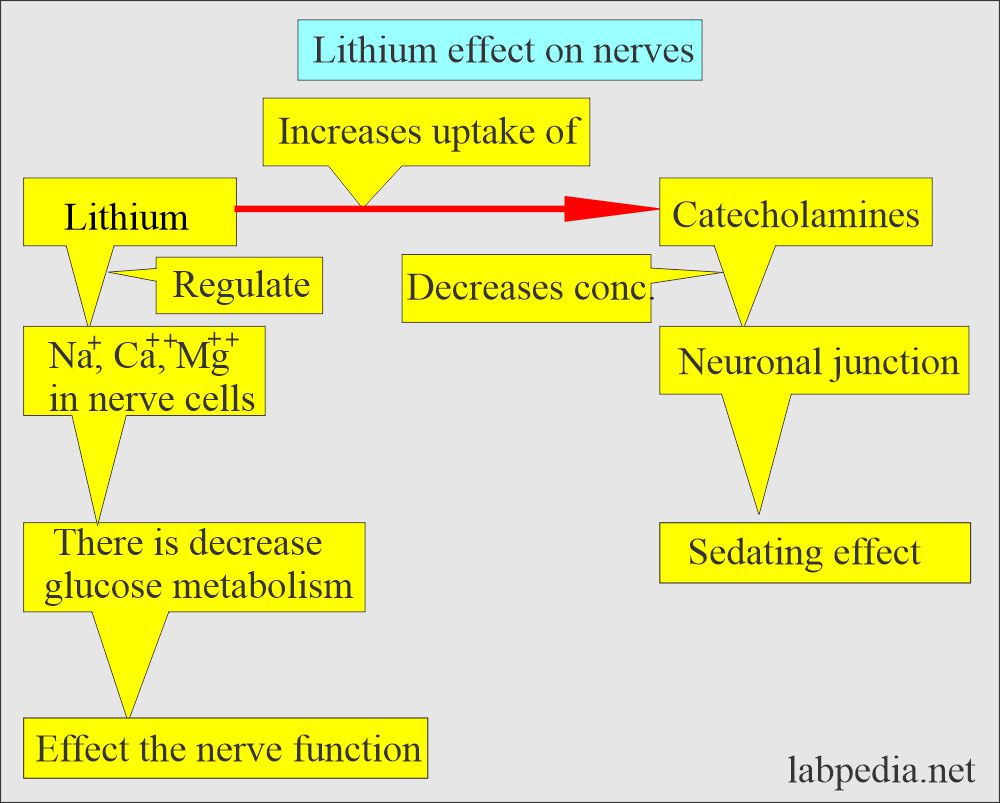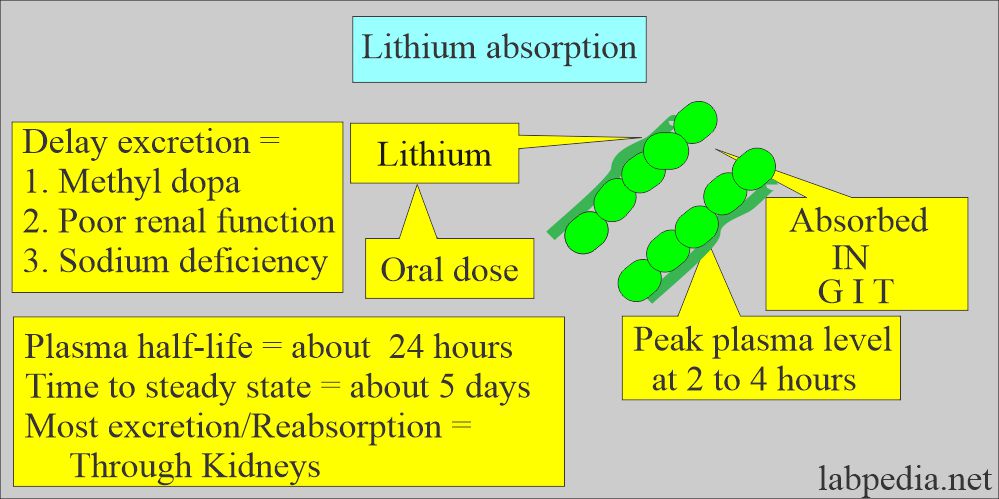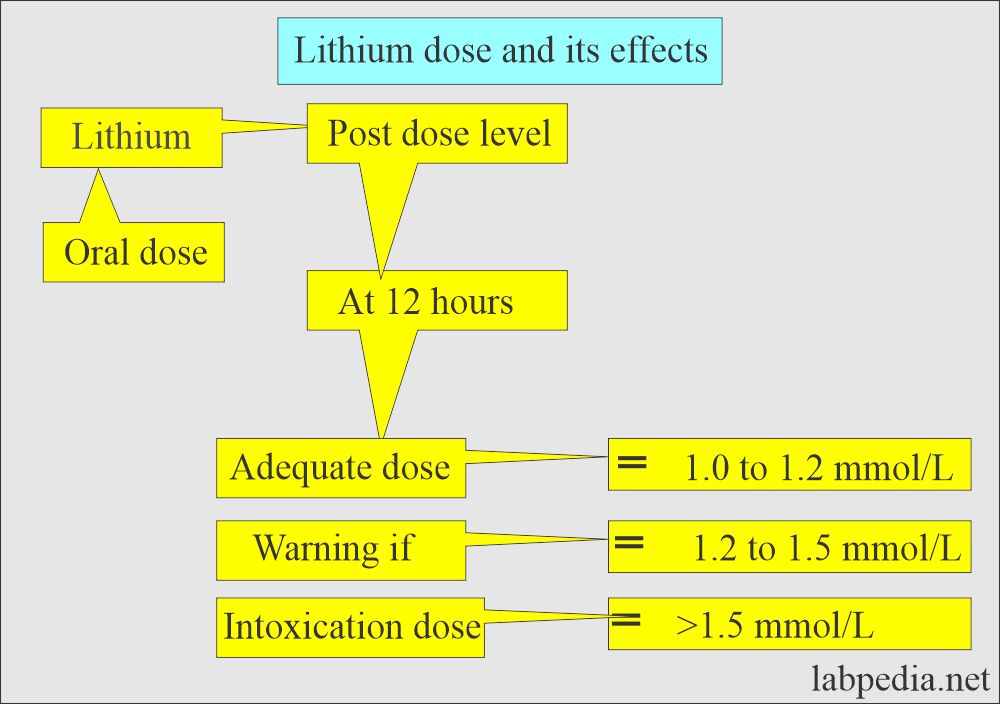Lithium
Lithium
What sample is needed for Lithium?
- It is done on the patient’s serum.
- The time to take the sample is 12 hours after the dose.
What are the indications for Lithium?
- It is used mainly in psychiatric patients on lithium therapy :
- Mania.
- Manic depressive illness (Bipolar affective disorder).
- The manic phase of the affective disorder.
- For the treatment and prevention of mania and people with bipolar disorders.
How will you define Lithium?
- Lithium, known as Eskalith or Lithane, Lithonate as lithonate carbonate, is given for treating the manic phase of mania, affective disorder, and manic depressive disease.
- This is present in the ultra-trace amount.
- Lithium is an element like sodium and potassium.
- Its salt may be found on earth in small quantities.
- The amount of lithium in river water and wells is very low.
- In plants and animals, the tissue is also low for lithium.
What is the mechanism of action of lithium?
- It is postulated that lithium helps in the reuptake of catecholamines, decreasing their concentration in the neuronal junction.
- This reduction of catecholamines at the neuronal junction produces a sedation effect on the central nervous system.
- Lithium also regulates the distribution of sodium, calcium, and magnesium in the nerve cells, reducing glucose metabolism that affects nerve function.
- Also, regulate the glucose metabolism that affects nerve function.
- The kidneys do the clearance. So in the case of renal damage, the clearance is delayed.
What is the mechanism of absorption of Lithium?
- There is the complete absorption of lithium from the GI tract.
- The peak level reaches within 2 to 4 hours after the intake of the drug.
- This is free in the blood and does not bind to the protein.
- The clearance in the blood is biphasic.
- First phase:
- 30% to 40% cleared with a half-life of 22 hours.
- Second phase:
- The remainder of lithium present in the ion pool is cleared with a half-life of 48 to 72 hours.
- The clearance is mainly dependent upon the renal function where active absorption occurs.
- Lithium passes through the glomerular membrane and is reabsorbed in the proximal convoluted tubules.
- In case of dehydration, fever, watery stool, vomiting, and hot weather intoxication of lithium, chances are increased.
- In the case of dehydration, the proximal tubular response to the reabsorption of sodium and lithium is the reduction of clearance.
- The decreased renal function causes prolonged clearance time.
- Lithium carbonate is used as a drug to treat patients with bipolar manic depression.
- When given to patients, it regulates the neurotransmission in the brain.
What is the therapeutic dose of Lithium?
- The lithium level should be monitored very carefully because the Level for the therapeutic and toxic doses is very narrow.
- Therapeutic level = 0.8 to 1.2 meq/L (meq/L = mmol/L).
- Maintenance dose = 0.5 to 1.2 mmol/L.
- Toxic level = >2.0 meq/L
- The standardized 12-hour postdose serum lithium concentration should be assessed as an adequate dose.
- The optimum level needs to be 1.0 to 1.2 mmol/L therapeutic dose.
- The concentration of lithium 1.2 to 1.5 mmol/L is the warning range.
- The lithium level >1.5 mmol/L in a 12-hour post-dose suggests a risk of intoxication.
- There is a lab variation of these values from lab to lab.
- Decreased dietary sodium leads to a decrease in the excretion of lithium.
What are the toxic doses of lithium?
- Lithium concentration of >2.5 mmol/L indicates severely intoxication by:
- Muscle rigidity.
- Hyperactive deep tendon reflex.
- Epileptic seizures.
When to stop the Lithium?
- The patient has dizziness, drowsiness, or a lack of energy.
- There may be muscle weakness and ataxia.
- The patient may have nausea, vomiting, or diarrhea.
- Difficulty in speech.
- There may be a lack of coordination.
- The patient may be confused.
- May get irregular tremors or shakes.
- There may be restlessness.
- There may be myoclonic twitching.
- There may be life-threatening seizures.
- Blood excretion of lithium is parallel to sodium excretion.
When to check the Lithium level and other blood tests?
- The recommended time for the lithium estimation is 12 hours after the dose.
- It is tested by flame photometry.
- Usually, lithium level is checked once a month for maintenance.
- RBC lithium level is better than the serum level. RBC levels are more stable because of the short half-life of Lithium in the serum.
- Also, renal functions and thyroid functions should be checked along with lithium levels.
- TSH level is increased in 30% of the cases.
- Lithium decreases testosterone levels.
- Recommended blood screening tests:
- Sodium, Potassium, Calcium, and phosphate.
- Renal parameters like BUN, Creatinine,
- Thyroid function tests like TSH and T4.
- Urine analysis (specific gravity and osmolality).
- Complete blood count (CBC).
What are the normal values of Lithium?
Source 2
- Therapeutic level: 0.8 to 1.2 meq/L
- Toxic level : > 2.0 meq/L
- (meq/L = mmol/L, both values are the same)
Source 4
- Acute mania = 0.6 to 1.2 meq/L
- Protection against future episodes in patients with bipolar disorder = 0.8 to 1.0 meq/L
- Toxic level = >2 meq/L
What drugs increase the Lithium levels?
- Indomethacin.
- Diclofenic.
- Hydrochlorothiazide.
What drugs decrease the Lithium level?
- Theophylline.
- Acetazolamide.
- Sodium bicarbonate.
- Urea.
- Spironolactone.
- Aminophylline.
What are the side effects of the raised level of lithium?
| Clinical presentation | If the lithium level is |
| Gastrointestinal symptoms | 1.5 to 2.0 meq/L |
| Tremors | 1.5 to 2.0 meq/L |
| Somnolence | 2.0 to 2.5 meq/L |
| Seizures | >2.5 meq/L |
| Death | >2.5 meq/L |
How will you treat patients with Lithium?
- Lithium is given to the patient as lithium carbonate.
Questions and answers:
Question 1: What is toxic dise of the lithium?
Question 2: What is the 12 hours post-dose lithium level suggesting a risk for intoxication?



